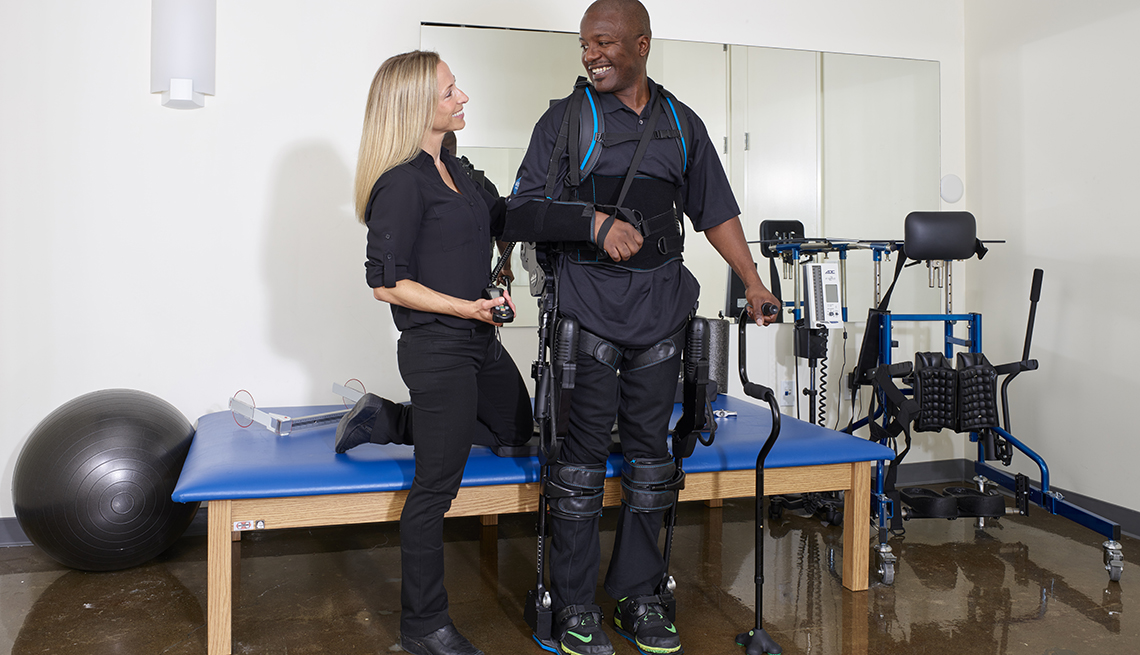Solving mobility challenges with new medical technology
Solving mobility challenges with new medical technology "
- Select a language for the TTS:
- UK English Female
- UK English Male
- US English Female
- US English Male
- Australian Female
- Australian Male
- Language selected: (auto detect) - EN
Play all audios:
Stroke is the primary cause of long-term disability in the United States, affecting approximately 795,000 people per year, predominantly those over 65. At St. Mary Rehabilitation Hospital in
Langhorne, Pennsylvania, as long as they are stable enough, patients can begin the process of movement retraining within days of suffering a stroke — in an exoskeleton. Bulky, heavy and
seemingly straight out of a blockbuster movie, the robotic harness isn't your average therapeutic device. Outfitted with a battery pack and motors in the joints, patients often invoke
the film _Robocop_ as they get used to the feeling of being enclosed by a therapeutic robot. Yet exoskeletons are just one breed of cutting-edge technologies that are having real impacts on
how older adults with mobility issues are able to get around — making it possible for more people to live fuller, more independent lives, both inside and outside the home. St. Mary physical
therapist Chrissy Colistro has been using the EksoGT exoskeleton as part of her practice since September 2018. Many of her patients are recovering from strokes, but she and her colleagues
have also used the device with those grappling with other neurodegenerative conditions, including multiple sclerosis and Parkinson's disease. Depending on the severity of a
patient's impairment, the exoskeleton may initially do all or most of the work for the user. By monitoring sensors in the exoskeleton, therapists can adjust how much the metal harness
compensates for each movement with the goal of retraining the muscles and nervous system. Some initial fear on the part of patients is common. "We get them into the device, and show
them – look, you just took 75 steps, when they'd struggled to do 10 feet with the therapist, holding on to the wall, with a lot of physical help,” Colistro says. “There are challenges,
but after they get to feel the proper movements after being in the machine, those movements carry over after they come out. That's the goal.” Ekso devices are in use in over 270
rehabilitation centers worldwide, and the company says that over 115 million steps have been taken in their devices. But they're just one of many companies in the exoskeleton market;
devices by four other manufacturers have earned approval by the Food and Drug Administration for use in therapy. Smaller wearables are also popping up; at Harvard, scientists are developing
more pliable versions intended to be worn beneath clothing. Mind-controlled versions may even be common in the future.
Trending News
'i wasn't well in the head' cheryl cole admits simon cowell was rightThe singer - who has made her comeback to the UK version of the show this year - opened up about the incident, which saw...
The uk government is feeding misinformation about migration — scottish national partyCONTACT Scottish National Party Gordon Lamb House 3 Jackson's Entry Edinburgh, Scotland EH8 8PJ tel: 0800 633 5432 ...
Tom brady reportedly had a concussion. What does that mean? Your guide to the latest scienceWhen Tom Brady’s wife casually mentioned this week that he’d suffered a concussion last season as he led the New England...
Boris johnson must beware of hubris, but should let himself be grilled by andrew neil | thearticleYou read it here first. The ball that Peter Kellner, the former president of YouGov, started rolling on _TheArticle_ las...
404 - Page not foundHomeNG HindiIndiaIndiaAndhra PradeshArunachal PradeshAssamBiharChhattisgarhGoaGujaratHaryanaHimachal PradeshJharkhandKar...
Latests News
Solving mobility challenges with new medical technologyStroke is the primary cause of long-term disability in the United States, affecting approximately 795,000 people per yea...
6 tips for winning in small claims court2. RESEARCH THE RULES AND LIMITS IN YOUR STATE If your demand letter does no good, find out if your case qualifies for s...
"coloured" news, research and analysis - the conversationOctober 28, 2024 Natasha Robinson, _University of Oxford_ The way Coloured identity is discussed in textbooks and curric...
The war that never went away | thearticleAzerbaijan and Armenia are at war — it was only four years ago that an estimated 200 people were killed in a conflict ov...
"the united kingdom remains strongly committed to its partnership with unicef"Speech "THE UNITED KINGDOM REMAINS STRONGLY COMMITTED TO ITS PARTNERSHIP WITH UNICEF" Statement by Ambassador ...
